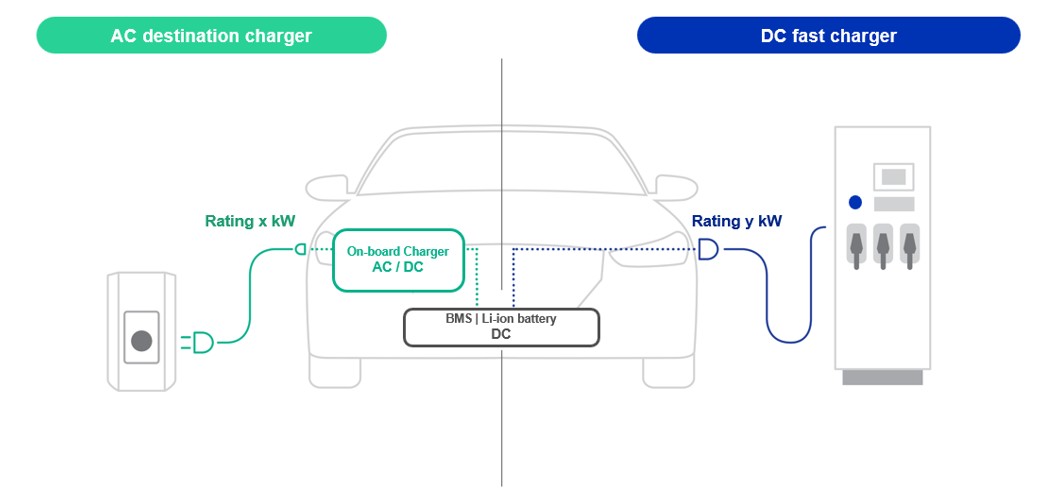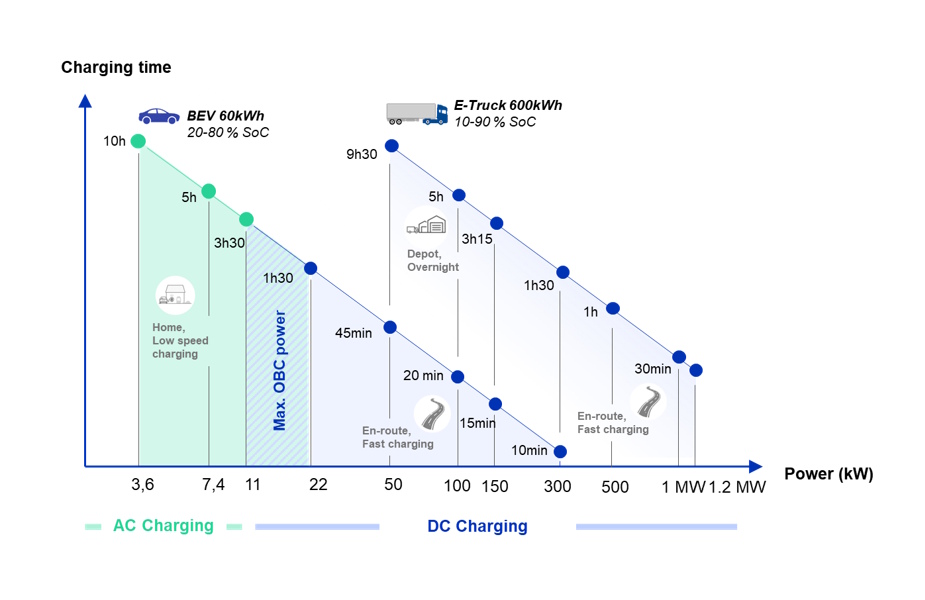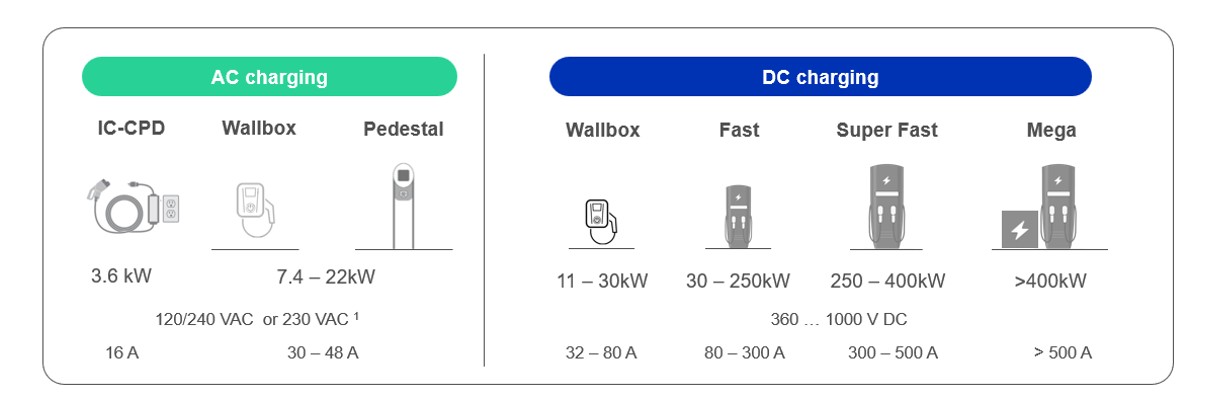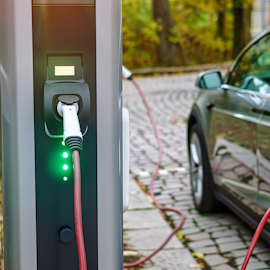One of the biggest challenges of the 21st century will be to decarbonize the traditional transportation accountable for over 25% of global CO2 emissions. Decarbonization must be done without sacrificing the interconnectedness we've come to expect from modernity. With a fleet of 157 mil of EVs expected in 2030, the electric vehicle supply equipment (or EVSE) needs to proceed in parallel, and sometimes anticipate that of the EV stock.
LEM actively contributes to the deployment of electric vehicle charging infrastructures, by supplying very high technology current sensors and energy meters making the charging points more reliable, safe, affordable, and smart.
Electrical Vehicle Supply Equipment applications
Successful deployment of EVSE goes hand in hand with simple recharging and energy management processes. This implementation requires the incorporation of new technologies and consistent development of robust standards that cater to various charging technologies suited for different applications.
Furthermore, there are significant indicators emanating from various regions that seek to accelerate the deployment of charging infrastructure, including regulatory initiatives such as the Alternative Fuel Infrastructure Regulation and the Fit for 55 law package in Europe, as well as programs like the NEVI in the United States.
To accomplish this, precise and innovative electrical measurement technologies are needed to perform functions such as current sensing, energy metering, and electrical safety.
Additionally, the infrastructure requires resilient current sensing technologies to ensure smooth operations.
Understanding EV Charging technologies for BEVs and E-Trucks
Charging Options for Passenger Battery Electric Vehicles (BEVs)
For passenger Battery Electric Vehicles (BEV), charging is performed using either using AC wallbox – using the automotive on-board charger (OBC) of the vehicle – or an off-board DC charger with a maximum charging power usually in the range of 100-250kW.
Selecting AC of DC charging point and power level for BEV will depend on the time available to charge and the desired charging range.
For passenger BEV application, AC charging points constitute most of the volume and are usually deployed in home and building while DC charging points are deployed for destination charging and en-route charging where time is an important constraint.

How to charge a BEV - AC and DC chargers
The Impact of High-Power Chargers Development on E-Trucks
With heavy-duty vehicles, particularly e-trucks, battery sizes are usually within the range of 300-600 kWh.
Using AC charging with an on-board AC/DC converter at conventional power levels of 11…22 kW would result in excessively long charging times, even for overnight depot charging.
Hence, it is anticipated that e-truck charging will predominantly rely on DC charging, ranging from 50 kW up to Megawatt charging.

Charging times and technologies for BEVs and E-trucks
The ongoing development of high-power chargers for passenger car BEVs directly benefits to this, with Direct Current chargers being widely available up to 400 kW and in development up to the megawatt scale.
Notably, regulations mandate a mandatory 45-minute break every 4.5 hours of driving. Under these conditions, and assuming standard consumption and speed, charging power in the range of 700-1000 kW is required for en-route charging of long-haul e-trucks.
Comparing AC and DC Charging: Speed, Cost, and Availability
Access to convenient and widely accessible electrical vehicle supply equipment is a cornerstone of the transition towards electrification in the transportation sector.
There are two options to charge a Battery Electric Vehicle (BEV): utilizing the on-board charger (OBC) of the BEV or connecting an external AC/DC converter directly to the BEV's battery.
The choice between AC and DC charging depends on factors such as available charging time and the cost of the charging technologies.
AC charging is often referred to as low-speed charging, employing cost-effective hardware. In contrast, DC charging allows for rapid charging because the power of the automotive OBC becomes no longer a limit, but necessitates more expensive equipment (the off-board DC fast charger).
DC fast charging is essential for on-the-go charging, meeting the demand for approximately 30-minute charging times for 20-80% State-of-Charge (SOC). It plays a crucial role in removing range anxiety and promoting widespread availability of charging points in public spaces.
On the other hand, AC charging constitutes the majority of chargers in residential areas, providing a substantial volume of charging options.

EV charging solutions: AC and DC chargers
AC Charging Stations Applications

AC chargers (Alternating Current chargers) are used to charge electric vehicles (EVs) by converting AC power from home or office supplies into DC power for the vehicle's battery. They are ideal for overnight or workplace charging but take longer than DC chargers. Current sensors in AC chargers measure output current and detect leakages to ensure safety and efficiency.
DC Charging Stations Applications

DC chargers (Direct Current chargers) rapidly charge electric vehicles (EVs) by converting AC power from the grid into DC power for the battery. They are faster than AC chargers, with DC fast chargers recharging an EV to 80% in 20-30 minutes, ideal for public stations and long trips. DC wall boxes, suitable for home or office use, offer lower power output and longer charging times but are more affordable.
PRODUCT DOCUMENTATION
As the demand for electric vehicles grows, so does the need for high-performance charging infrastructure. Discover how LEM’s advanced current sensing technologies help enhance the efficiency, safety, and reliability of EV Supply Equipment.
Our EV Charging Solutions Brochure provides in-depth insights into how our innovative solutions can transform your EV charging systems for a cleaner, more sustainable future.
NEED SUPPORT ON YOUR PROJECT?
You have a project in line with that application and want to discuss it with LEM?
Click on the contact button below and our experts will help you find the best solutions for your needs.